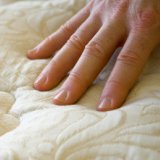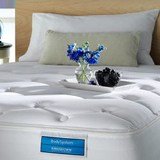Futon Mattress
Tips for Choosing a Futon Frame and Mattress
A futon mattress was once acceptable furniture for only a college dorm room or first apartment. Today, futons are purchased for the purpose of outfitting a guest room or providing additional comfortable seating in any room of the house.
History of the Futon
The sleeping surface we know in the United States as a futon actually originated in Japan. The Japanese people have slept for years on what is called a shikibuton, which is essentially the futon mattress we know today.
On top of the shikibuton was what we might call a topper or as they referred to it, a kakebuton. These two pieces sat upon a sleeping mat called a tatami, which was the piece that was placed underneath the shikibuton in order to keep it from coming into contact with the floor. The Japanese design was a two-part system.
Each morning, the shikibuton and the kakebuton were taken outside to air out. Each piece was beaten using a bamboo cane and then hung so the air could flow through the fabrics. This way, a clean and refreshed sleeping surface was ready each night.
Sometime during the late 1960s this idea of a Japanese sleeping mat became popular in the U.S. We called it a futon and laid it directly onto the floor for sleeping.
The wooden futon frame entered the U.S. market in the 1970s. The original shikibuton in Japan and the futon in the United States were filled with all-cotton materials.
The mattress choices in the U.S. changed in the 1970s when some manufacturers began to offer futons filled with wool, polyester, and foam for varying levels of comfort.
The 1980s and 1990s were the years during which the futon business and industry took off in the U.S. Now we can find substantially built futon mattresses and frames that are not only comfortable for sitting and sleeping, but are also pieces that add warmth and coziness to our home's décor.
Today's Futon - Types and Choices
The futon in the western market refers to a three-part system: the futon frame and mattress, and the slipcover. The benefit of using a futon frame is that it keeps your futon off the floor, and can be adjusted for multiple purposes.
Futon Frames
Futon frames come in three different folding styles: bi-fold, wall-hugger, and tri-fold. All futon frames are manufactured from either wood or metal.
The design of the futon is such that the frame becomes part of your decorating theme because quite a bit of it is exposed. Metal frames are naturally less expensive than wood frames.
The futon frame mechanism by which you turn your futon into a sleeping position from a sitting position is important too when choosing a futon. The types include:
- Ratchet or click-clack - very fluid motion to change from the seated position, to reclining, and then to the sleeping position
- Kicker - one fluid motion to change the futon position with this one also, but it also features the ability to push or pull the seat to a 90-degree angle or flat
- Sliding pivot point - primarily found on the wall-hugger style futon which means you don't have to move the futon frame at all in order to put it down into a sleeping position
Mattresses for Futons
The futon mattress is definitely not your typical college dorm sleeping surface any longer. The choices available today are much softer and plusher than the original all-cotton filled mattresses.
- All cotton - traditional style mattress that is still popular for it's flexibility as both a seating area and sleeping area.
- Cotton/Polyester - these are lighter in weight than all cotton mattresses, softer to the touch, and more flexible. Depending on the percentage of polyester used, it can serve as a firmer mattress.
- Cotton/Foam - these are the top-selling futons to date because they are amazingly light and wonderfully comfortable.
- Cotton/Wool - more expensive than other futon mattresses, the wool is the most durable of the materials offered.
- Innerspring - yes, there is such a thing! This design is ideal for those consumers who are more comfortable with the idea of a traditionally designed mattress, but love the flexibility and versatility of a futon design. This style mattress is heavier than the others and carries a higher price tag.
- Organic futon mattresses - you can find futon mattresses filled with 100% organically grown cotton or there are mattresses that are manufactured with combinations of 100% organic cotton, wool, and latex.
Prices range from $100 - $325, depending on the mattress style. Organic mattresses are significantly higher priced at $800-$900.
Futon Slip Covers
The futon slip cover serves as a mattress protector, but most importantly, it is the piece de resistance for turning any normal-looking futon into an amazing piece of furniture that fits perfectly into your décor. Futon slipcovers come in cotton, cotton blends, chenille, tapestry, jacquard, or micro suede.
Benefits of Futons
- Easy and convenient to use
- Much less expensive than a sleeper sofa or traditional mattress
- Convertible piece of furniture - duals as a couch or a bed
- Extremely comfortable
- Customizable - choose the frame and slip cover that matches your décor
- Manufactured from high-quality and durable materials
- Simple to move from room to room, or for those who relocate often
- Perfect for any room of the home
Drawbacks of Futons
- Some styles are bulky and heavy, and not as easy to move around
- Some 100% cotton futon mattresses tend to sag or become hard after prolonged use
- Futons require assembly at home
- Too soft or too firm sleeping surface for some people
- Some futon frames which convert to a couch are at an awkward angle for comfortable seating
Tips for Buying a Futon
You get what you pay for! Especially when buying online, beware of ridiculously low prices. Buy brand names that have received good reviews.
Inquire about how the futon is packaged - if it's not packaged correctly, you could receive a dirty wet mess of a mattress.
Tufting is essential! Futons should be tufted all over to prevent the mattress contents from shifting over time.
A quality futon should be covered with a durable fabric.
Purchase a mattress that is a minimum of 6-inches thick or else you may not be pleased with the comfort of the mattress.
Ask about the frame warranty and the mattress warranty. The frame warranty should be at least 5 years.
Futons used occasionally need not be as durable as those used every day.
Try out a futon prior to purchase whenever possible.
Let us know your own experiences of sleeping on a mattress on a futon style bed using our comments box below.
Thanks for your contributions.
Have You Used a Futon Mattress?
Have you use a futon mattress? What do you like best about it? What brands of futon do you prefer? Do you have any tips for buying a good futon?
What Other Visitors Have Said
Click below to see contributions from other visitors to this page...
Pros and cons of a few different types of futons Not rated yet
I have slept on two types of futons: 100% cotton and cotton layered with foam rubber. The all-cotton futon will be very firm from the start and will compact …
I Loved my Futon but it Became Flat Not rated yet
When I was younger I moved around a lot and I found it really helpful to sleep on a futon, because I could roll it up easily to transport when I moved. …
Let's All Sleep Better
Help us to spread the word!
Simply copy and paste this code into your Facebook page or blog. Thank you for sharing!



New! Comments
Share your thoughts about what you just read! Leave me a comment in the box below.